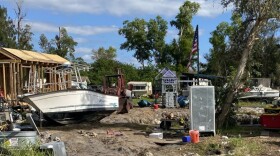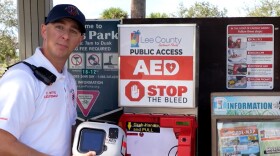Three of Southwest Florida's most influential environmental groups, each with a laser focus on the region’s water quality, met Tuesday to share a report warning that the next massive red tide or blue-green algae outbreak will be a multi-billion-dollar disaster.
“Our region's economic and ecological well-being hinges on the health of our water. Yet, while there’s almost universal agreement that our water fuels our economy, our water quality continues to decline,” said Rob Moher, president of the Conservancy of Southwest Florida.
“The findings of this report are dire, and must serve as a wake-up call – to the public, to elected officials, and to community leaders," Moher continued. "We cannot afford to wait any longer for meaningful action to clean up and protect our precious water resources.”
The Conservancy, Sanibel-Captiva Conservation Foundation, and Captains for Clean Water commissioned the report, in which research economists from a firm in Washington state detail why hundreds of billions of dollars in economic woe would ensue if a harmful algae bloom locked into place along Charlotte, Lee, and Collier county’s coasts.
"While there’s almost universal agreement that our water fuels our economy, our water quality continues to decline”
- Rob Moher of the Conservancy of Southwest Florida
The nonprofits said the purpose of this report is to measure the impacts of poor water quality on Southwest Florida, which has been degraded by changes to the flow of the River of Grass from development in the 1900s, overuse of fertilizers and other chemicals by both industrial agriculture operations and generations of family farms around Lake Okeechobee, and more recently the state’s booming population.
The research in the 177-page report overwhelmingly finds harmful algae blooms – red tide and blue-green algae being the most common destructive types in Southwest Florida -- are major threats to economic prosperity.
Industries that are integral to Southwest Florida’s economy would be severely impacted, that report found, if a bloom settled in along the three counties anytime soon.
Big blooms of 2018
This is, by no coincidence, exactly what happened not too long ago.
Lake Okeechobee and the Caloosahatchee River were inundated with blue-green algae, which is a slimy, green, freshwater bloom known for its potential to produce toxins that can be harmful to both the environment and human health.
At the same time, a severe red tide settled into the salty coastal waters and caused massive fish kills – even of massive fish like goliath grouper and whale sharks -- and coated beaches, over and over, with dead fish carcasses for months.

The red tide lasted so long that it stretched past the 2018 calendar year in either direction, starting in 2017 and not dissipating until 2019. It took several years for fish stocks to rebound from Ten Thousand Islands north to Anna Maria Island near Tampa Bay.
The simultaneous algal blooms caused significant ecological damage by impacting both freshwater and marine ecosystems, and the economic losses piled up due to the loss of tourists, the toxins’ impact on marine life, and public health.
The study found if what happened surrounding 2018 happens again in 2024 or 2025 it would result in the loss of $460 million in commercial and recreational fishing, more than 43,000 jobs, $5.2 billion in local economic output, $17.8 billion in property values, and the related loss of $60 million in property tax revenue.
The trio of environmental firms hired Greene Economics, based in Ridgefield, WA, a small, all-female consulting firm with “environmental economists” that focuses on climate change issues as well as natural resource economics, water management, and regional economic impacts.
Wet winter
This winter has been a very wet one in Southwest Florida due to the El Nino weather patterns causing so much rainfall in what should be the Sunshine State’s dry season.
Lake Okeechobee has never dropped back below its pre-Hurricane Ian levels, so the three environmental nonprofits believe there is serious potential for a harmful water-quality event in the coming months.
James Evans, CEO of the Sanibel-Captiva Conservation Foundation, said having the report is a critical resource moving forward because it finally provides measurable economic data that policymakers need to make proactive investments in solutions that will prevent damaging events in the future — like faster work on the Everglades restoration.
Evans said nobody expects to unbuild Fort Myers or Miami, but what can be done is to hurry up and complete the dozens of projects to restore the water flow in the Everglades just like it’s been drawn up.
“That is the roadmap to be able to store treat and convey water south into the Everglades where it's desperately needed,” James said. “Instead of discharging that water into the Caloosahatchee watershed from Lake Okeechobee where it's causing damage and contributing to those harmful algal blooms that cripple our economy.”
James also said he feels like policymakers in Glades, Hendry, Lee, and Charlotte counties have prioritized development that sends water into coastal estuaries and coastal communities that cause harm, instead of prioritizing the Everglades’ projects that can store and treat that water.

Daniel Andrews, director of Captains For Clean Water, said their study may focus on the billions of dollars of negative economic impact that poor water quality and harmful algae blooms can cause, a day at the beach without any blooms of weird colors or rotten smells is priceless.
“The ability to go out on the beaches here — with family, friends, loved ones, your kids—and just enjoy a sunset without having to deal with dead, rotten fish washing up, without having to smell the pungency of red tide with every inhale you make,” he said. “There is no price tag you can put on that."
Environmental reporting for WGCU is funded in part by VoLo Foundation, a non-profit with a mission to accelerate change and global impact by supporting science-based climate solutions, enhancing education, and improving health.
Sign up for WGCU's monthly environmental newsletter, the Green Flash, today.
WGCU is your trusted source for news and information in Southwest Florida. We are a nonprofit public service, and your support is more critical than ever. Keep public media strong and donate now. Thank you.








